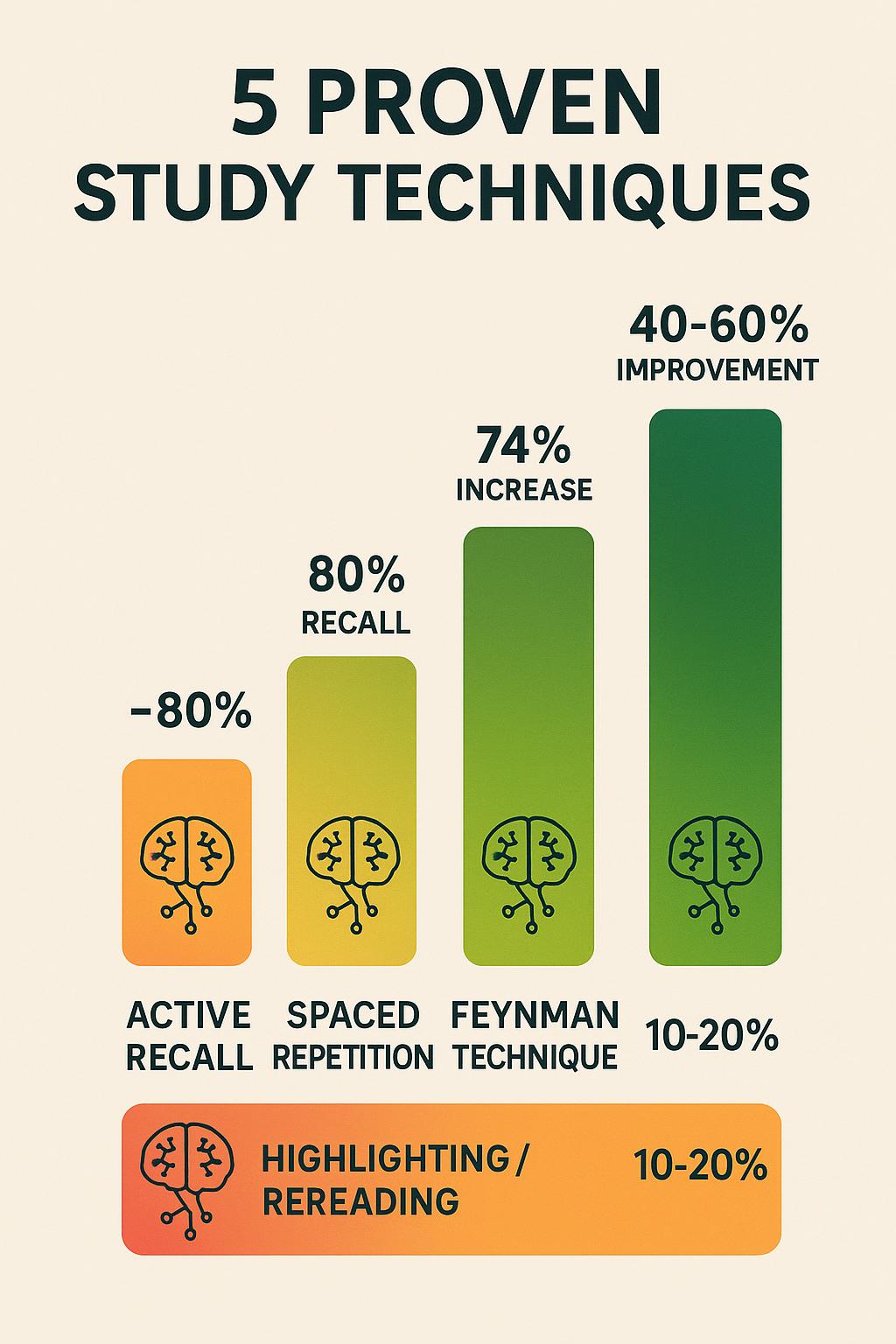Mastering midterm exams requires more than just traditional studying methods like highlighting or rereading textbooks. Evidence-based study techniques can transform your exam preparation, boosting retention from a mere 20% with passive methods to an impressive 80% with the right approach.
Key Takeaways
- Active recall is 44% more effective than passive review methods
- Using spaced repetition can improve retention by up to 74%
- The Feynman Technique forces deeper understanding through simplification
- Interleaving different subjects improves problem-solving ability by 40-60%
- Creating concrete examples makes abstract concepts stick in your memory
The Science of Effective Studying: Evidence-Based Approaches
When it comes to exam preparation, understanding how your brain actually forms and retains memories can revolutionize your study approach. Cognitive science reveals that our brains don’t work like recording devices—they actively construct memories through neural connections that strengthen with specific types of engagement.
Traditional study methods like highlighting and rereading notes yield disappointingly low retention rates of only 10-20%. These passive techniques create an illusion of knowledge because the material seems familiar when reviewed, but this familiarity doesn’t translate to actual recall ability during midterm exams.
Active Recall: Test Yourself to Remember
Active recall is the practice of retrieving information from memory rather than simply reviewing it. Research by Karpicke & Roediger found that students who practiced retrieval remembered about 80% of material a week later, compared to only 36% for those who relied on rereading.
This technique works by strengthening neural pathways through what psychologists call the generation effect. Each time you pull information from memory, you’re actually reinforcing those neural connections, making future retrieval easier and more reliable.
To implement active recall for your college midterms, start by converting your notes into questions. For example, instead of reviewing “The three branches of government are executive, legislative, and judicial,” write: “What are the three branches of government?”
Flashcards represent one of the most versatile active recall tools available to students. Digital options like Anki add the benefit of built-in spaced repetition algorithms, but physical cards work well too, especially for visual learners.
For mathematics and science subjects, solve problems without looking at examples first. This forces your brain to actively retrieve the relevant formulas and processes rather than simply recognizing them.
Spaced Repetition: Timing Is Everything
Spaced repetition involves strategically reviewing information at increasing intervals over time. This technique directly combats Ebbinghaus’ Forgetting Curve, which shows how rapidly we forget information when we don’t review it (about 70% is lost within 24 hours).
Research demonstrates that spaced learning can increase long-term retention by up to 74% compared to cramming. The optimal spacing effect, studied extensively by researchers Bjork & Bjork, shows that slightly challenging retrieval attempts create stronger memories than easy, immediate reviews.
To create an effective spaced repetition schedule for midterm study, review new material within 24 hours of first learning it, then again in 3 days, 1 week, and 2 weeks. Adjust these intervals based on difficulty—review challenging material more frequently and easy material less often.
Digital tools make implementing spaced repetition remarkably straightforward. Apps like Anki, RemNote, or Quizlet handle the scheduling algorithms automatically, allowing you to focus solely on the retrieval practice itself rather than managing review timelines.
The Feynman Technique: Teaching to Master
Named after Nobel Prize-winning physicist Richard Feynman, this technique involves explaining concepts in simple language as if teaching someone else. The power of this method lies in its ability to expose knowledge gaps you might not realize exist when simply reviewing notes.
Research on elaborative interrogation and self-explanation shows that students who explain concepts to themselves or others score up to 30% higher on subsequent tests. This technique works because simplification forces deeper processing and metacognitive awareness of what you actually understand versus what merely seems familiar.
To implement the Feynman Technique for your midterms, choose a concept and write everything you know about it on a blank sheet of paper. Identify gaps in your explanation, revisit your source material to fill those gaps, then simplify your language until you can explain the concept to a 12-year-old.
For example, instead of “Photosynthesis is the biochemical process by which plants convert light energy to chemical energy that can later be released to fuel cellular activities,” you might say: “Photosynthesis is how plants make their food using sunlight, water, and air.” This simplification forces you to truly understand the underlying concept.
Dual Cognitive Techniques: Interleaving and Concrete Examples
Interleaving involves mixing different but related topics or problem types rather than studying one topic completely before moving to another. Studies show this technique improves problem-solving abilities by 40-60% compared to blocked practice because it trains your brain to distinguish between different types of problems and select appropriate strategies.
For effective interleaving during midterm study, alternate between different question types or subjects in a single study session. For instance, if studying mathematics, mix problems requiring differentiation with those requiring integration rather than completing all differentiation problems before moving to integration.
Complementing interleaving, concrete examples involve attaching specific, vivid examples to abstract concepts. Research on context-dependent memory shows that students who generate their own examples retain information 2-3 times more effectively than those who only study provided examples.
Here are some ways to implement both techniques for proven study hacks that maximize midterm performance:
- Create a study schedule that alternates between subjects or topic areas within a subject
- For each abstract concept, develop personal examples that relate to your life experiences
- Practice applying concepts across different contexts to strengthen flexible recall
- Build a personal example library in your notes for quick review before exams
Combining these five proven study hacks—active recall, spaced repetition, the Feynman technique, interleaving, and concrete examples—creates a powerful system for midterm exam preparation. These techniques don’t just help you pass tests; they build durable knowledge that serves as a foundation for future learning.
Sources
NCBI: The critical importance of retrieval for learning
Psychological Science in the Public Interest: Improving Students’ Learning
Psychological Science: Learning Techniques
Gwern.net: Spaced Repetition for Efficient Learning
ScienceDirect: The Power of Testing Memory










